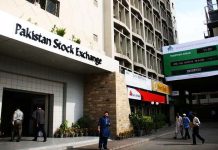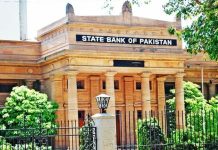ISLAMABAD: The government has recently exceeded its treasury bill (T-bill) auction target by an astounding 72%, raising concerns among economic experts despite a wave of optimism from the banking sector. This outcome follows the State Bank of Pakistan’s (SBP) recent decision to cut its policy rate for the first time in nearly four years.
The government successfully raised Rs776.7 billion against a target of Rs450 billion in the T-bill auction. This surge in government borrowing comes at a time when the SBP has reduced its policy rate by 150 basis points to 20.5%, a move anticipated to further ease in the coming months.
Despite the policy rate cut, the government maintained the cut-off yield on three-month T-bills at 20.14%, while marginally reducing the yield on six-month papers to 19.96% and on 12-month papers to 18.54%. The auction attracted significant bids, with banks showing a strong preference for longer-term papers. Bids for six-month T-bills reached Rs997.2 billion, with the government raising Rs446.6 billion, the highest amount for any tenor in the auction.
However, the substantial increase in government borrowing has raised red flags among economic analysts.
Dr Hamid Haroon, a former economist at the World Bank, cautioned that the government’s heavy reliance on bank borrowing could have severe repercussions. “While the immediate influx of funds may seem beneficial, the long-term economic implications are worrisome. The high level of debt servicing required will strain the government’s finances and limit its ability to invest in crucial development projects,” he warned.
The government’s borrowing spree is not a recent phenomenon. Data from the State Bank shows that the government borrowed Rs7.765 trillion from banks till June 14, 2024, significantly higher than Rs4.374 trillion borrowed in the corresponding period last year. This year’s borrowing has exceeded the combined figure of the preceding two fiscal years, reflecting the government’s high spending needs amid revenue generation challenges.
Banking sector experts, on the other hand, remain optimistic. Dr Haris Khan, an economist at the Institute of Bankers Pakistan, pointed out that the banks’ eagerness to invest in long-term T-bills indicates confidence in future interest rate reductions. “The banking sector is positioning itself for an expected decline in interest rates. By locking in current yields, banks are aiming to secure favourable returns in anticipation of a more accommodating monetary policy,” he explained.
However, this optimism is not shared universally.
Hamid Haroon stressed that the high cost of borrowing due to elevated interest rates had pushed up the cost of doing business to unsustainable levels. “As banks channel more funds into government securities, the private sector is left struggling to access affordable credit, stifling entrepreneurial activity and economic growth,” he noted.
The situation will be further complicated by the government’s record borrowing levels during the outgoing fiscal year. By relying heavily on bank loans to finance its budget, the government faces the challenge of allocating almost all tax revenue toward debt servicing. This has left limited resources for development projects, which are essential for long-term economic growth and infrastructure development.
Analysts also expressed concerns over potential inflationary pressures. While inflation slowed to 11.8% in May, the latest budget measures could fuel inflation, keeping interest rates high and negatively impacting economic stability.
“The budgetary measures introduced may counteract the positive effects of the rate cut, leading to sustained high inflation and interest rates. This scenario is far from ideal for economic recovery,” said Dr Haroon. –INP






